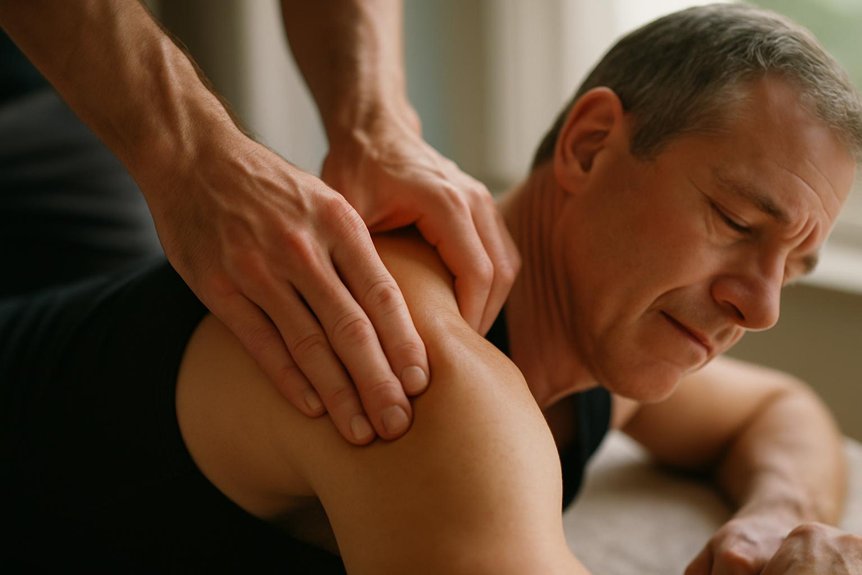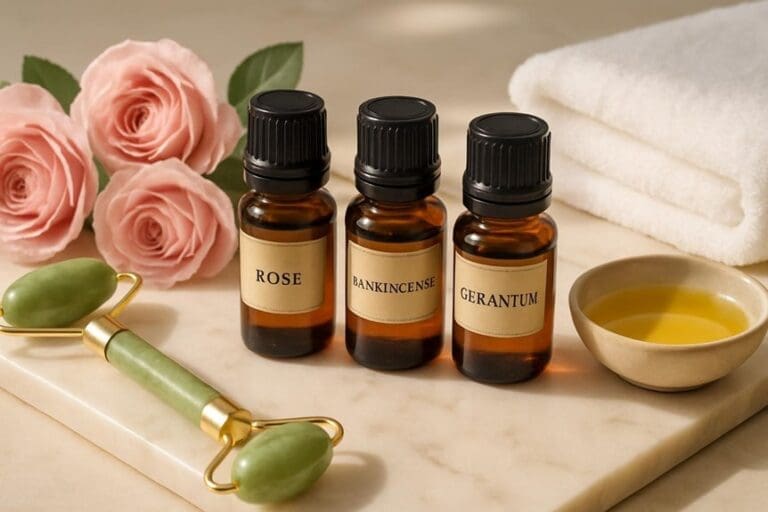It can assist in managing frozen shoulder (adhesive capsulitis) by applying targeted pressure to disrupt adhesions and release myofascial restrictions in the glenohumeral region. This technique enhances local circulation, reduces pain, and gradually restores range of motion by addressing capsule tightness and periarticular muscle tension. Clinical evidence supports these mechanical and neurophysiological effects when tailored to individual tolerance and limitations. Further practical details outline how this approach is implemented and integrated with aftercare strategies.
Understanding Frozen Shoulder: Causes and Symptoms

Frozen shoulder, medically termed adhesive capsulitis, is characterized by progressive stiffness and pain in the glenohumeral joint. This condition typically arises when the connective tissue surrounding the shoulder joint—the joint capsule—undergoes thickening and contracture, leading to restricted mobility.
The aetiology often involves preceding shoulder immobility, trauma, or systemic conditions such as diabetes mellitus.
Clients may first notice a dull, aching discomfort, which gradually intensifies and restricts both active and passive range of motion. Common symptoms include difficulty performing overhead movements and night-time pain that disrupts rest.
At Spa & Massage clinics, understanding these clinical presentations enables therapists to recognize the nuanced onset and progression, supporting clients through each phase of adhesive capsulitis with empathy and informed care grounded in anatomical knowledge.
In many cases, expert intervention using deep tissue massage techniques may help alleviate muscular tension and promote improved shoulder mobility.
How It Works
It employs sustained pressure and slow strokes targeting the deeper layers of fascia and musculature. This technique aims to disrupt adhesions and fibrotic tissue that often develop in the glenohumeral joint capsule during frozen shoulder.
At Spa & Massage clinics, therapists utilize anatomical expertise to identify and address myofascial restrictions, carefully manipulating affected tissues to promote improved mobility.
The methodical application of pressure stimulates local circulation, enhancing nutrient exchange and potentially modulating the inflammatory response.
Through precise, intentional movements, therapists seek to reduce hypertonicity in surrounding muscles, fostering an environment conducive to tissue remodeling.
Clients often appreciate the attentive, individualized approach that underpins each session, fostering trust and therapeutic rapport.
Benefits of Intensive Tissue Massage for Frozen Shoulder
It confers several therapeutic benefits for individuals experiencing adhesive capsulitis, commonly known as frozen shoulder. This modality targets the deeper layers of musculature and connective tissue, focusing on areas of chronic tension and myofascial adhesions around the glenohumeral joint and scapulothoracic region.
Evidence suggests that deep tissue manipulation can enhance local circulation, thereby facilitating the delivery of oxygen and nutrients essential for tissue repair. By systematically addressing fibrosis within the shoulder capsule, therapists at Spa & Massage aim to reduce pain, increase joint mobility, and encourage gradual restoration of normal range of motion.
Many clients report a perceptible release of tension and a sense of relief, contributing to improved daily function and comfort throughout the rehabilitation process.
What to Expect During a Session at Spa & Massage
During a session at Spa & Massage, clients with frozen shoulder undergo a personalised assessment and consultation to determine the best approach.
Therapists employ targeted deep tissue techniques that prioritise patient comfort and address specific musculoskeletal restrictions.
Following treatment, clients receive evidence-based aftercare guidance and home exercise recommendations to support ongoing recovery.
Personalised Assessment and Consultation
Prior to administering any intensive tissue massage for frozen shoulder at Spa & Massage, a thorough personalised assessment and consultation is conducted by a qualified therapist.
This initial phase involves a detailed review of the client’s medical history, current symptoms, and the specific limitations experienced in the glenohumeral joint.
The therapist evaluates range of motion, patterns of pain, and the presence of muscular guarding or adhesions in surrounding tissues such as the deltoid, rotator cuff, and scapular stabilisers.
Palpation techniques are used to identify areas of hypertonicity and trigger points.
Throughout the consultation, the therapist maintains open communication, ensuring client comfort and trust.
This tailored approach forms the foundation for an effective, safe, and nuanced treatment plan, aligned with individual goals and sensitivities.
Techniques Tailored for Comfort
A session at Spa & Massage addressing frozen shoulder employs specialised intensive tissue massage techniques focused on the glenohumeral joint and surrounding musculature. Therapists apply slow, deliberate pressure to the deltoid, rotator cuff group, and scapular stabilisers.
They use forearms, thumbs, and elbows to access deeper fascial layers. Each manoeuvre is adjusted to the client’s tissue response, ensuring comfort while facilitating myofascial release and improved joint mobility.
Communication is encouraged throughout, allowing for immediate feedback and *most suitable* pressure modulation. The use of high-quality massage oils reduces friction, enabling precise, controlled strokes without irritation.
This tailored approach seeks to decrease adhesions, minimise discomfort, and enhance local circulation. Spa & Massage therapists prioritise both therapeutic efficacy and the client’s sense of safety and relaxation.
Aftercare and Home Advice
Following intensive tissue massage for frozen shoulder at Spa & Massage, clients commonly experience transient localised soreness and increased tissue warmth due to augmented circulation and myofascial release.
This response typically resolves within 24–48 hours. To optimise recovery, therapists at Spa & Massage recommend gentle, active range-of-motion exercises and application of a warm compress to support tissue pliability.
Clients are advised to maintain adequate hydration post-session, which facilitates metabolic waste clearance from manipulated tissues. Restorative sleep and avoidance of intensive upper limb activity enhance the therapeutic effects.
Should persistent discomfort arise, consultation with the treating therapist is encouraged.
At Spa & Massage, aftercare guidance is tailored to individual anatomical presentation, supporting both physiological healing and emotional comfort for clients experiencing the vulnerability of frozen shoulder.
Tailoring Massage Techniques for Shoulder Mobility
At Spa & Massage, therapists employ targeted muscle release to address myofascial restrictions around the glenohumeral joint. This approach supports improved range of motion.
Gentle stretching methods are incorporated to elongate periarticular tissues while minimising discomfort.
Personalised pressure adjustment is utilised to accommodate individual tissue sensitivity and optimise therapeutic outcomes.
Targeted Muscle Release
When addressing frozen shoulder, precise application of targeted muscle release is essential for restoring glenohumeral joint mobility and alleviating capsular stiffness.
At Spa & Massage, therapists identify hypertonic musculature—such as the subscapularis, infraspinatus, and deltoid—that often contribute to restricted range of motion. Using deliberate, anatomically informed techniques, pressure is applied to myofascial trigger points and adhesions, facilitating localized tissue relaxation and improved circulation.
This methodical approach helps decrease nociceptive input and modulate chronic pain, supporting the joint’s natural healing process. Clients often report a deep sense of relief and increased comfort following sessions, as these muscle release strategies are tailored to individual patterns of restriction.
Such nuanced care fosters trust, allowing each person to experience gentle, attentive restoration of functional movement.
Gentle Stretching Methods
While addressing adhesive capsulitis, gentle stretching methods serve a pivotal role in promoting glenohumeral joint mobility without exacerbating inflammation or discomfort.
At Spa & Massage clinics, therapists employ passive range-of-motion techniques, carefully guiding the shoulder through flexion, abduction, and external rotation within a client’s tolerance. These stretches target the joint capsule, rotator cuff, and periarticular tissues, supporting gradual elongation of fibrotic structures.
Clinical evidence suggests such interventions, when performed systematically, can decrease synovial adhesions and restore functional capacity. Throughout each session, the therapist’s attentive monitoring of resistance and pain cues ensures safety and comfort, fostering trust and relaxation.
Personalised Pressure Adjustment
Personalised pressure adjustment constitutes a critical aspect of intensive tissue massage for frozen shoulder, guaranteeing therapeutic efficacy while minimising the risk of exacerbating pain or inflammation.
At Spa & Massage, therapists employ a nuanced approach, adapting pressure intensity in response to the client’s pain threshold and tissue response. Precise palpation of the glenohumeral joint, rotator cuff musculature, and periarticular soft tissues allows targeted intervention without provoking undue discomfort.
By modulating pressure and technique—ranging from sustained, deep strokes to lighter effleurage—therapists facilitate myofascial release and enhance capsular mobility.
This tailored methodology fosters trust, safety, and excellent outcomes by respecting individual sensitivity and promoting gradual restoration of shoulder range of motion.
Ongoing feedback is encouraged to ensure each session aligns with the client’s evolving therapeutic needs.
Aftercare Tips to Support Recovery
Following a intensive tissue massage for frozen shoulder, ideal recovery relies on adherence to targeted aftercare protocols.
At Spa & Massage, therapists recommend gentle passive and active range-of-motion exercises to maintain glenohumeral joint mobility and prevent adhesions.
Application of cold packs may reduce transient inflammation, while hydration supports tissue recovery and metabolic waste removal.
Clients are advised to avoid strenuous overhead activities for 24 hours post-session, allowing muscle fibers and connective tissue to adapt.
The use of unscented, hypoallergenic oils in our clinics minimizes dermal irritation.
Self-massage using light effleurage around the deltoid and scapular region can prolong therapeutic effects.
Clients are encouraged to communicate sensations of pain or increased stiffness during subsequent visits to promote ideal, compassionate care.
When to Seek Additional Help or Alternative Therapies
How can clients identify when intensive tissue massage alone is insufficient for managing frozen shoulder symptoms? Persistent pain, restricted range of motion, or lack of functional improvement after several sessions may indicate the need for additional intervention.
In these cases, clients are encouraged to seek assessment from a qualified physiotherapist or musculoskeletal specialist to rule out underlying pathology such as rotator cuff tears or adhesive capsulitis progression.
At Spa & Massage, therapists support clients in recognising these signs, fostering open communication and collaborative care.
When symptoms remain refractory, adjunct therapies—such as medical imaging, corticosteroid injections, or targeted rehabilitation—can complement massage.
Timely referral guarantees an integrated approach, addressing both soft tissue restrictions and joint capsule pathology, and supporting clients’ holistic well-being throughout their recovery journey.
Conclusion
In summary, intensive tissue massage may be nothing short of revolutionary for individuals tormented by adhesive capsulitis, potentially transforming rigid, immobile glenohumeral joints into near-miraculous models of flexibility. By applying targeted, evidence-based manual therapy to deeply restricted myofascial structures, skilled therapists at Spa & Massage could release a world of movement previously deemed unattainable. While not a universal cure, this intervention stands as a beacon of hope for restoring ideal shoulder biomechanics and mitigating persistent pain.



